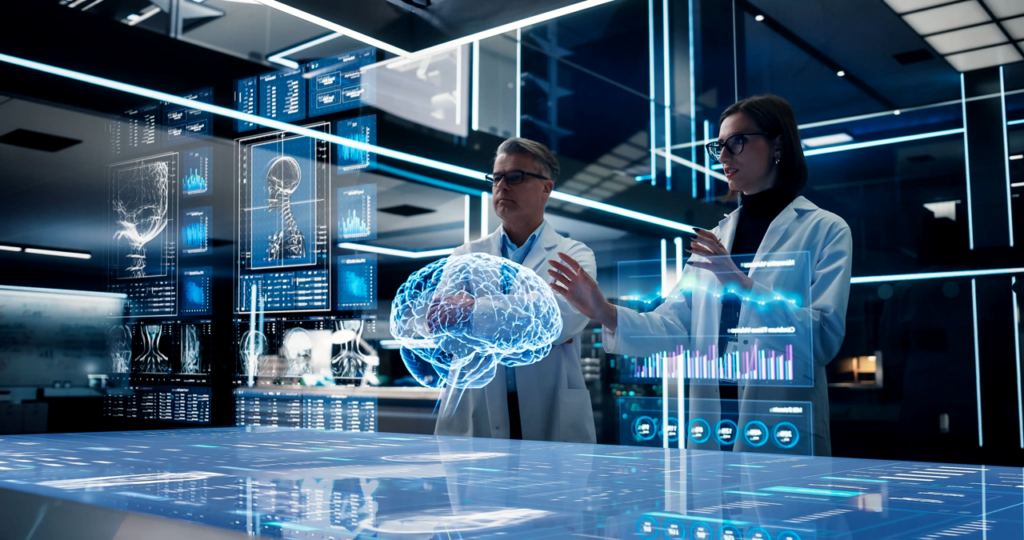
In today’s digital age, the synergy between technology and neuroscience has become a subject of intense exploration. The human brain, with its intricate neural networks, is both a beneficiary and a subject of technological advancements. This article delves into the fascinating realm of neuroscience to uncover the profound impact of technology on brain function and innovation.
Read More: Innovations in Mental Health Tech: Changing the Game
Contents
Understanding Neuroscience

What is Neuroscience?
Neuroscience is a multidisciplinary field encompassing biology, psychology, and medicine, focused on unraveling the mysteries of the nervous system. It seeks to understand the structure and function of the brain, spinal cord, and peripheral nerves, and how they give rise to cognition, behavior, and emotions.
Importance of Neuroscience in Understanding the Brain
Neuroscience plays a pivotal role in elucidating the complexities of the brain. By employing techniques ranging from molecular biology to neuroimaging, researchers can probe the brain’s inner workings and decipher its role in shaping human experience and behavior.
The Influence of Technology on the Brain
Positive Effects of Technology on Brain Functioning
Technology has revolutionized the way we learn, communicate, and engage with the world. Educational tools, such as interactive simulations and online courses, leverage technology to enhance learning outcomes and stimulate cognitive development. Similarly, social media platforms provide avenues for connectivity and social interaction, promoting emotional well-being and a sense of belonging.
Negative Effects of Technology on Brain Health
However, the pervasive use of technology also poses challenges to brain health. Excessive screen time, particularly among children and adolescents, has been linked to issues such as digital eye strain, disrupted sleep patterns, and attention deficits. Moreover, the incessant barrage of information and stimuli from digital devices can contribute to stress, anxiety, and feelings of overwhelm.
Neuroplasticity: How the Brain Adapts to Technology

Neuroplasticity, the brain’s remarkable ability to reorganize and adapt in response to experience, lies at the heart of our capacity to learn and innovate. The advent of technology has provided new avenues for neuroplasticity to manifest, as individuals adapt to the demands of navigating digital interfaces and processing vast amounts of information. This phenomenon, often referred to as “tech brain,” underscores the dynamic nature of the brain and its capacity for continuous evolution.
Innovations in Neuroscience and Technology
Brain-Computer Interfaces (BCIs)
BCIs represent a groundbreaking fusion of neuroscience and technology, enabling direct communication between the brain and external devices. By decoding neural signals, BCIs offer a pathway for individuals with paralysis or neurological disorders to interact with their environment and regain agency over their lives. Moreover, BCIs hold promise for enhancing human capabilities, from controlling prosthetic limbs to augmenting cognitive function.
Virtual Reality (VR) and Augmented Reality (AR)
VR and AR technologies immerse users in virtual environments or overlay digital information onto the real world, blurring the lines between physical and digital realms. These immersive experiences have applications across diverse fields, from healthcare and education to entertainment and gaming. VR-based therapies, for instance, have shown promise in treating phobias, PTSD, and chronic pain by exposing individuals to controlled simulations of triggering stimuli.
Wearable Technology for Brain Monitoring
Advances in wearable technology have ushered in a new era of personalized healthcare, with devices capable of monitoring brain activity in real time. Electroencephalography (EEG) headsets and functional near-infrared spectroscopy (fNIRS) sensors allow for non-invasive measurement of brain function outside of laboratory settings. These wearable devices hold the potential for early detection of neurological disorders, optimization of cognitive performance, and rehabilitation following brain injury.
The Future of Tech and Neuroscience Integration

As technology continues to evolve at a rapid pace, so too will our understanding of the brain and its potential. The integration of tech and neuroscience holds promise for addressing some of the most pressing challenges facing society, from neurodegenerative diseases to mental health disorders. By leveraging the power of innovation and collaboration, we can unlock new frontiers in brain research and usher in a future where technology enhances human flourishing and resilience.
Read More: The Latest Breakthroughs in AI Technology
FAQs
- Is technology rewiring our brains? While technology can reshape neural pathways through neuroplasticity, it’s not necessarily “rewiring” our brains in a negative sense. Instead, it’s influencing how we process information and interact with the world around us.
- How can I protect my brain from the negative effects of technology? Setting limits on screen time, taking regular breaks, and engaging in activities that promote cognitive health, such as exercise and mindfulness, can help mitigate the negative impact of technology on the brain.
- Are there ethical concerns surrounding the use of BCIs? Yes, ethical considerations arise concerning privacy, consent, and potential misuse of BCI technology. It’s essential to address these concerns through thoughtful regulation and ongoing dialogue among stakeholders.
- What are some practical applications of VR and AR in healthcare? VR and AR are being used for medical training, surgical planning, pain management, and exposure therapy for phobias and PTSD, among other applications.
- How might wearable brain-monitoring devices benefit individuals with neurological disorders? Wearable devices could provide real-time feedback on brain activity, helping individuals with conditions like epilepsy or ADHD manage their symptoms more effectively and allowing clinicians to monitor treatment progress remotely.
The Final Words
The intersection of technology and neuroscience offers boundless opportunities for exploration and discovery. By unraveling the mysteries of the brain and harnessing the power of technology, we can unlock new insights into human cognition, behavior, and creativity. As we navigate the ever-changing landscape of the digital age, it is imperative to approach technological innovation with mindfulness and ethical consideration, ensuring that our advancements align with the values of human dignity and well-being.








One Comment